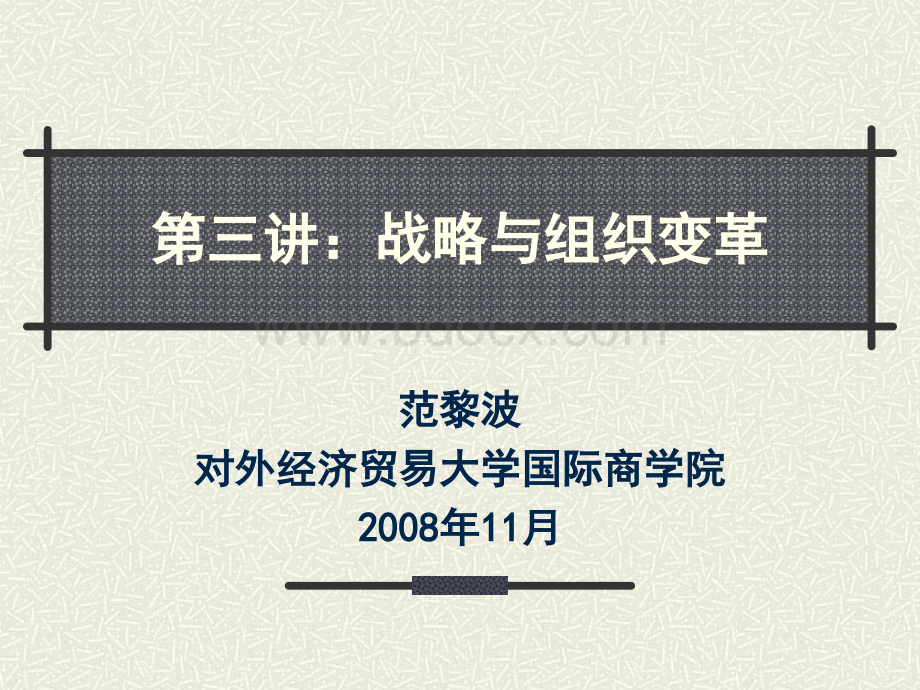管理学原理--第三讲:组织变革.ppt
《管理学原理--第三讲:组织变革.ppt》由会员分享,可在线阅读,更多相关《管理学原理--第三讲:组织变革.ppt(39页珍藏版)》请在冰豆网上搜索。

第第三讲:
战略与组织变革三讲:
战略与组织变革范黎波范黎波对外经济贸易大学国际商学院对外经济贸易大学国际商学院20082008年年1111月月第十三章:
组织变革与创新第十三章:
组织变革与创新MANAGINGCHANGEANDINNOVATION引言引言作家加德勒(作家加德勒(JohnJohnCardlerCardler)说过:
)说过:
大多数有问题的组织是因为滋生了大多数有问题的组织是因为滋生了功能性功能性的盲目,看不到自己的缺点。
的盲目,看不到自己的缺点。
它们的症结并不在于无法解决问题,它们的症结并不在于无法解决问题,而是根本看不到问题。
而是根本看不到问题。
你是否知道事情在发生?
你是否能你是否知道事情在发生?
你是否能够看到事情发生?
你是否可以令事够看到事情发生?
你是否可以令事情发生?
情发生?
LearningObjectivesYoushouldlearnto:
nContrastthecalmwatersandwhite-waterrapidsmetaphorsofchangenDescribewhatmanagerscanchangeinorganizationsnExplainwhypeoplearelikelytoresistchangenListtechniquesforreducingresistancetochangeLearningObjectives(cont.)DescribethesituationalfactorsthatfacilitateculturalchangeExplainhowprocessreengineeringisrelatedtochangeDifferentiatebetweencreativityandinnovationExplainhoworganizationscanstimulateandnurtureinnovationWhatIsChange?
Changenalterationsinpeople,structure,ortechnology,andculturenchangeisanorganizationalrealitynmanagingchangeisanintegralpartofeverymanagersjobForcesForChangeExternalForcesnmarketplacenTechnologynlabormarketsneconomic-uncertaintiesaboutinterestrates,budgetdeficits,andcurrencyexchangeratesForcesForChange(cont.)InternalForcesnoriginatefromtheoperationsoftheorganizationnforcesmayincludestrategy,workforce,newequipment,oremployeeattitudesManagerinitiatives-asChangeAgent13-8TwoViewsOfTheChangeProcessTheCalmWatersMetaphornchangeisabreakintheorganizationsequilibriumstatenLewinsthree-stepmodelnunfreezing-preparingfortheneededchangeby:
nincreasingthedrivingforcesthatdirectbehaviorawayfromthestatusquondecreasingtherestrainingforcesthatpushbehaviortowardsthestatusquonchanging-movetoanotherequilibriumlevelnrefreezing-makechangepermanentTheChangeProcessTwoViewsOfTheChangeProcess(cont.)White-WaterRapidsMetaphornconsistentwithuncertainanddynamicenvironmentsnconsistentwithaworldincreasinglydominatedbyinformation,ideas,andknowledgenmanagersmustcontinuallymaneuverinuninterruptedrapidsntoday,managersmustbereadytoefficientlyandeffectivelymanagethechangesfacingtheirorganizationsortheirworkareasThreeCategoriesOfChangeWorkspecialization,departmentalization,chainofcommand,spanofcontrol,centralization,formalization,jobredesign,oractualdesignStructureAttitudes,expectations,perceptions,andbehaviorPeopleWorkprocesses,methods,andequipmentTechnologyTheCategoriesOfChangechangingstructure-organizationsformaldesign,centralization,degreeofformalization,andworkspecializationnstructuralcomponentsandstructuraldesignchangingtechnology-modificationsinthewayworkisperformednalterationsinthemethodsandequipmentusednconsequenceofcompetitivefactorsorinnovationswithinanindustrynautomation-replacestasksdonebypeoplewithmachinesncomputerization-recentvisiblechangesininformationsystemschangingpeople-changesinemployeeattitudes,expectations,perceptions,andbehaviornorganizationaldevelopment(OD)-techniquesorprogramstochangepeopleandthenatureandqualityofinterpersonalworkrelationshipsnintendedtohelpindividualsandgroupsworktogethermoreeffectivelyOrganizationalDevelopmentTechniquesMoreEffectiveInterpersonalWorkEnvironmentProcessConsultationIntergroupDevelopmentSensitivityTrainingSurveyFeedbackTeamBuildingDealingwithResistancetoChangeWhypeopleresistchangenchangereplacestheknownwithambiguityanduncertaintynchangethreatensinvestmentsinthestatusquonbeliefthatchangeisincompatiblewiththegoalsandinterestsoftheorganizationTechniquesforreducingresistancenavarietyofactionsavailabletomanagerstodealwithdysfunctionalresistanceManagerialActionstoReduceResistancetoChangeContemporaryIssuesInManagingChangeChangingOrganizationalCulturencultureresistanttochangebecauseitismadeupofrelativelystableandpermanentcharacteristicsnstrongculturesareparticularlyresistanttochangenUnderstandingtheSituationalFactors-makesculturalchangemorelikelyndramaticcrisisoccursnleadershipchangeshandsnorganizationisyoungandsmallncultureisweakContemporaryIssues(cont.)ChangingOrganizationalCulture(cont.)HowCanCulturalChangeBeAccomplished?
nrequiresacomprehensiveandcoordinatedstrategynunfreezethecurrentculturenimplementnew“waysofdoingthings”nreinforcethosenewvaluesnchange,ifitcomes,islikelytobeslownprotectagainstanyreturntoold,familiarpracticesandtraditionsTheRoadtoCulturalChangeContemporaryIssues(cont.)ContinuousQualityImprovementProgramsncontinuous,small,incrementalchangesnfixandimprovecurrentworkactivitiesnrelyonparticipativedecisionmakingfromthebottomlevelsProcessReengineeringndramaticshiftinthewayanorganizationdoesitsworknbeginswiththeredesignofworkndefinecustomerneedsndesignworkprocessestobestmeetthoseneedsnrequiresparticipationfrommanagersandworkersContinuousQualityImprovementVersusReengineeringContinuousQualityImprovementContinuous,incrementalchangeFixingand